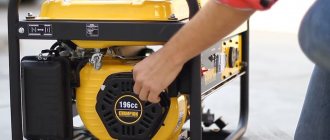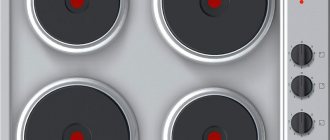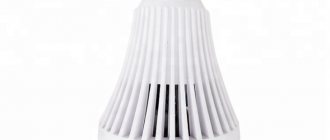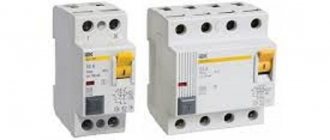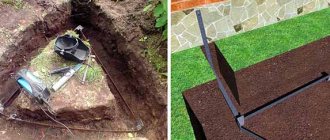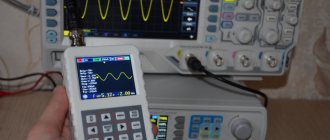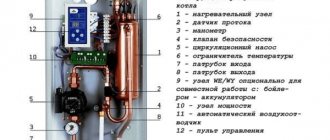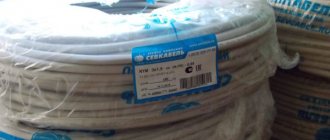Heat guns are a mobile electric fan heater that can be used to heat a garage, house or apartment. There are thermal guns of direct and indirect (indirect) heating. It is the second type of equipment that is considered safer and suitable for residential premises.
The heat gun can be used in two different situations. It can be either the only or an additional source of heat generation:
- in the first case, during winter, a household electric heat gun for the home is an excellent heater for the garage! And not only. In construction work, when quick intensive drying of the finish is needed, heat guns play an important role;
- in the second case, there is work in winter in shops, offices, and shopping pavilions. Also, a large factory workshop or hangar can be equipped with electric guns; many supermarkets use similar industrial directional thermal fans for heating.
Prices for heat guns vary, as there is a device for a car room, and there is one for an airport that warms up the runway.
For car owners, heat guns will do an excellent job (for example, Timberk TIH R2 5K). In severe frosts, not every car starts the first time. Therefore, the device for car rooms performs the main service in warming up a frozen car. In just 10 minutes, a hot stream from a heat gun directed at the hood puts the car in a combat-ready state. Particularly popular are guns with a timer and thermostat, which do not require constant monitoring of the operation of the unit.
There is another option. Often among men there are amateurs - car mechanics. Such men do not leave their metalworking machines in technical rooms even in severe frost. A garage heater is fully suitable for amateur mechanics, as it will not only warm the air in the garage/outbuilding/shed to an acceptable temperature. At the same time, such an electric heat gun will be able to raise the temperature of surrounding objects, which means that metals will not burn your hands with cold. A stationary water heat gun is also perfect for this option.
In other words, an air heat electric gun for technical rooms will be the best winter purchase for any man if:
- you have an unheated room for your car, and at low enough temperatures your car won’t start;
- you have an unheated non-residential premises in which turning and plumbing (or other) equipment is installed, and you need to work at low temperatures.
Other types of heat guns
Industrial guns can also be liquid fuel. This is a diesel gun, a gasoline gun or a diesel fuel thermal gun. Diesel is characterized by its low cost and lowest consumption, which makes units running on diesel fuel the most profitable for users. The gas air gun is widely used for installing suspended ceilings, as evidenced by numerous reviews from craftsmen. And for faster heating of rooms, including greenhouses, ceramic heat guns are used.
You can select and order inexpensive thermal guns with delivery throughout Moscow and Russian regions in the online store website.
The leading position in the heating equipment market is occupied by heat guns, which are used to heat residential, industrial and warehouse premises, garages, greenhouses, offices, sales areas, country buildings, etc. An air heater with a built-in fan quickly pumps in warm air, which creates a comfortable microclimate even in severe frosts.
- Multi-fuel, including liquid fuel. The device is ideal for car services: the owner saves on heating the room by using drained motor oil. Such units operate for more than ten hours without a break.
- Gas heat guns. They are autonomous and stationary. Such equipment is widely used in the agricultural industry. The gas burner located inside the device promotes uniform heat distribution. A device running on natural gas consumes a small amount of electricity, which allows for significant savings.
- Electric heat guns are widely used both in everyday life and in production. Modern models are equipped with a spiral or tubular electric heater. The latter has a long service life. All such devices are equipped with an electric fan heater and thermostat that maintains a constant temperature and prevents overheating.
- Infrared heat guns. They do not have a fan. The radiated heat increases the temperature of surrounding objects. The air warms up due to heat transfer. Such devices are used during repair work to uniformly dry walls and ceilings.
- Diesel heat guns. They quickly heat the room and are used during construction work in winter. There are direct and indirect heating models. The power of diesel heat guns is greater than that of multi-fuel units.
IMPORTANT!
Electric heat guns with a power exceeding five kilowatts should be connected to a three-phase power supply system.
Which heat gun to choose to solve a specific problem
A wide range of heating units makes it difficult to choose for a specific task. Which heating device models are best suited for an apartment, and which device is better to buy for a garage?
For heating a living space
When choosing a heating device for a house or apartment, it is necessary to take into account the area of the room, the properties of the building materials from which the walls are built (wood, brick), as well as the presence of thermal insulation.
The best option is an electric heat gun.
For living rooms, you should purchase indirect heating guns. In such devices, the burner flame is isolated and combustion products are removed through the exhaust system. Indirect heating guns are safe for humans and pets.
ATTENTION!
In a private home, a heat gun is simply irreplaceable, because with it you can not only warm up, but also dry out basements and cellars and get rid of mold.
For heating a warehouse
It is irrational to use electrical appliances for heating hangars and warehouses due to high energy costs. When choosing a device, you should take into account the weather conditions of the region. For mild climates, gas guns are suitable; for climate zones with harsh winters, a direct heating device running on diesel would be an ideal option.
Greenhouse gun
When creating greenhouse conditions for growing garden crops, summer residents give preference to gas heating units.
Diesel or electric appliances are sometimes used. The main requirement for installing the device: the heat gun should be suspended from the roof of the greenhouse so that the pumped warm air does not burn the leaves of the plants.
IMPORTANT!
Thanks to the mesh heater, the rectangular guns do not dry out the air in the room.
General criteria for choosing the right heat gun
What parameters should you definitely pay attention to:
- Determination of power.
It takes one hundred watts to heat 1 m². It turns out that for a room with an area of 100 m² you will need a heating device with a power of at least 10 kilowatts. For a more accurate calculation of power, the height of the ceilings and the number of windows and doors are taken into account. - Presence of combustion products.
Direct heating devices are suitable for open construction sites. They are installed for rooms with a good ventilation system. - Autonomous heat guns work less than stationary ones.
Stationary devices are characterized by high performance. Despite their impressive size, they are considered more economical than miniature heating devices. - Safety.
The device housing must be resistant to mechanical damage. Sensors that are triggered when the device overheats are designed to prevent damage and fire. To increase the level of safety, manufacturers produce models that automatically turn off in the event of a rollover. - Quiet operation.
A humming device operating for several hours in a row negatively affects a person’s well-being. The noise level produced must be within reasonable limits. Units that produce a noise level of less than 40 decibels during operation do not create additional stress on the hearing aid. - No suspicious odors.
Some heating devices, the design of which is dominated by plastic parts, emit an unpleasant chemical odor. Ceramic heaters are considered the safest. - Easy installation and ease of use.
For temporary heating of a house or apartment, it is better to choose models that do not require a chimney or ventilation system. They just need to be connected to the power supply system. - Compactness
. Rectangular and cylindrical heating units take up less space than models running on diesel or gas. Another advantage of electrical appliances is their mobility.
The cold climate motivates us to study the top rating of the best heat guns for home and garden. Compared to conventional heaters, heat guns can quickly heat an apartment, a frozen cottage, a production workshop or a warehouse. The main thing is to define the selection criteria.
Having come to the idea that you need to purchase a heat gun, you immediately find yourself faced with the question: “How to choose it?” The answer is simple. It is necessary to rely on such criteria as the volume of the room, the number of people present there, and what type of fuel will be used, since most of the modern guns begin to function on gas, diesel and electricity. To calculate the thermal power required for your room, a simple formula was invented: V x T x K = kcal/h. One kilowatt is equivalent to 860 kilocalories per hour.
- V is the volume of the room that needs to be heated;
- T is the temperature difference;
- K is the dissipation coefficient, depending on the type of construction of the house and its degree of insulation.
But you shouldn’t trust the formula entirely, since circumstances play a decisive role. That is, the number of window openings in the house, the number of doors located and, of course, the height of the ceiling.
The heat gun market is constantly moving, expanding, something new appears, but in general, if we summarize, we can distinguish three types: electric, gas and diesel guns. Each existing type of gun has its own advantages and disadvantages.
Video explanation for calculating the power of a heat gun:
Electric guns
When there are no problems with electricity in the room, then electric guns are a good option, they are the most affordable and easy to use. On what principle do these heat guns work? Of course, from the network. If the gun model has a power of up to 5 kTv, then it is powered from a 220 volt network; if the gun is more powerful, then a 380 volt network is required.
Their mobility, ease of use, and the absence of the need to use other fuels have brought them well-deserved popularity, both in everyday life and in construction.
The heat is distributed throughout the room due to the fact that the fan blows it and distributes it evenly throughout the room.
Gas guns
Gas guns have two undeniable advantages - low price and light weight of the models. Their power varies from 10 to 100 kTV, although there are more. Gas guns operate on gas, which is supplied through a cylinder reducer or thanks to a centralized gas network. When the gas burns, the heat exchanger heats up. The air passing along the heat exchanger is also heated, thus creating heat in the room.
Gas guns are very economical, but there is still a drawback. Liquefied gas in cylinders cannot be purchased everywhere, and it is difficult to stock up due to a number of storage requirements.
Diesel guns
Diesel guns run on fuel such as diesel fuel and have a common operating principle with gas guns, although their design is more complex.
Among the advantages of guns, it is worth noting their remarkable cost-effectiveness. By filling the gun once with diesel fuel, you can be provided with continuous 10-15 hour operation of the equipment. Delivery of diesel fuel is safe and is not connected to the gas main. Well, the power of diesel guns is not inferior to gas guns.
The disadvantages of diesel guns are their heavy weight and the fuel, which contains contaminants. Because of the last point, they should be used in non-residential premises where there is good ventilation.
Heat guns for direct and indirect heating
Speaking about diesel guns, it is worth noting that they are divided into two types: direct and indirect heating. This means that a direct heating heat gun evaporates all combustion products directly into the air. Accordingly, it would be advisable to use a direct heating diesel gun in open areas, such as construction sites, or in non-residential premises.
An indirect heating heat gun has a special exhaust system for combustion products, which means it can be used to warm up unventilated rooms.
How to choose a convector heater - device, selection criteria and operating rules
Today, convector-type wall heaters have become very popular. They not only work very quietly and do not take up much space, but also look very aesthetically pleasing. However, they are not only beautiful and compact, but also effective. These devices are perfect for both apartments and offices. We hope that this article will answer all questions about how to choose a convector heater correctly, taking into account all its necessary characteristics.
How does a convection heater work?
The operation of the device is based on the fact that hot and cold air have different densities. Therefore, heavier air with a low temperature accumulates closer to the floor, and warm air, being lighter, flies up to the ceiling. There are two slots in the body of any convector: one at the top, the other at the bottom. They are designed to allow air of different temperatures to pass through. So the operation of the device is simple: cold air enters the device through the lower slot, heats it up with the help of a heating element, becomes lighter, passes through the upper slot and ends up under the ceiling.
This type of heater has a simple design. Inside the metal case, which is small in width, there is a heating element powered by electricity. The heating temperature is regulated by a thermostat, the handle of which is located on the external panel. The body uses metal with a thickness of 0.8 millimeters. So, in fact, we looked at how a convector heater works. There are three types of heating elements for these heaters. Each of them will be discussed below.
Disassembled electric convector and its heating element.
1. A tape (or needle-type) heating element is a dielectric plate of small width, on both sides of which there are loops made of a chromium-nickel alloy. These hinges can be easily damaged as they are very fragile. Therefore, now manufacturers have practically abandoned the manufacture of such heating elements. Moreover, they heat the air too slowly due to the lack of fins. Here the body of the device itself heats up, and warm air follows it.
2. The tubular type heating element (otherwise known as heating element) has been deservedly recognized as the most popular for several decades. The heater tube, along its entire length, has aluminum fins. The more there are and the more often they are located, the higher the heat transfer.
- The tube has a temperature much lower than the nichrome thread hidden inside it.
- The heating element lasts quite a long time - longer than a tape heater.
- Such a heater can operate in rooms where the humidity is very high. In this case, protection class IP24 applies.
- During operation, a small annoying cracking sound is often heard. This occurs due to the difference in temperature expansion of aluminum plates and steel tubes.
- There is a space between the aluminum plates, which are the ribs, and the steel tube, which increases over time. This leads to heat loss.
3. There is another type of heating elements - monolithic. They are designed differently. The same nichrome thread is placed in a cast aluminum housing with fins, and a dielectric backfill is used to isolate them from each other. Here, if heat loss is observed, it is minimal - after all, the difference in temperature expansion no longer exists. These heating elements are good for everyone: they are quiet, and the body of the device heats up little and practically does not lose heat.
Since the body of the device is hollow inside, it serves as a kind of wind tunnel in which thrust is created by heating the air. While the convector is connected to the network, the process of cold air passing through the heating element, heating it and flowing upwards continuously occurs. And so, portion by portion, the entire air of the room is gradually heated.
Convectors today are available in a wide variety of designs.
The first two models can have a height of up to forty-five centimeters. The latter are much lower - only up to twenty centimeters in height, but they have an impressive length - sometimes up to two and a half meters. When thinking about how to choose an electric convector for installation under a window opening, it makes sense to choose a similar model. Due to their large length, moving them is not very convenient, but you can be sure that the air in the lower part of the room will be thoroughly heated.
Appearance of a plinth-type convector.
Wall-mounted electric convectors.
Convectors are installed in two ways:
They have wheels and a handle to move around the floor. But the heaters are mounted on the wall with special brackets. Thanks to this, wall-mounted models do not take up any extra space in the room. In addition, they can fit well into modern interior design.
Tips for choosing a convector
When choosing a convector heater, we take into account its following characteristics:
- Power consumption;
- Type of heating element;
- Device dimensions;
- Operational safety;
- Additional features;
- Price;
- Manufacturer;
- Indicators during inspection.
1. So, power. It is selected based on the size of the room to be heated. For example, if you plan to use the device in addition to heating during the period when you are not heating it yet or are no longer heating it, then we calculate the power as follows: for each cubic meter of room volume you need 25 watts of power. But if there is no heating in the house at all, then you will have to calculate based on 40 watts per cubic meter.
Let's give an example: if the area of the room is 19 square meters, the ceilings are 2.7 tenths of a meter, we calculate the power of the heater in the off-season by multiplying these two values by 25. We get 1285.5 watts. We round up and look for a heater with a power of one and a half kilowatts.
2. Type of heating element. As for the heating element, if you have a choice, take a heater with a cast monolithic heater - it will last longer and work more efficiently.
3. Dimensions of the device. When inspecting the device, pay attention to its dimensions, especially its height. After all, it depends on it how fast the air will move. For example, low convectors with a height of only 60 centimeters are able to ensure very rapid movement of air masses and, accordingly, heat the room faster. It is also important how heavy the device is - after all, you may have to move it from place to place during use.
4. Operational safety. The heater must be as safe as possible. As a matter of fact, convectors are the safest heating devices. After all, their body only heats up to 60 degrees, no more, and therefore will not leave burns. Parents of small children, talking with each other about how to choose convector heaters, give preference to models in which the body has no corners and has smooth contours. Grounding is not necessary for convectors, and they can withstand voltage drops with flying colors.
5. Additional features. Among the additional features that a good convector has, the following can be noted:
- The temperature regulator is a very convenient thing. If it’s warm outside, you can turn it up a little, and if it’s very cold, set it to maximum.
- The thermostat will allow you to constantly maintain the temperature in the room that is most comfortable for you.
- The timer will make it possible to turn on the heater for a certain time, after which the shutdown device will operate. It’s a good idea to use this opportunity in the evening, before going to bed.
- The built-in ionizer absorbs dust, saturating the air with negative ions. It is very good for health. In a room with such a microclimate, you sleep better and work more productively.
- The remote control and on-timer will allow you not to get out from under a warm blanket in the morning to heat the room.
- Rollover protection is a very important feature, especially if you have playful animals or fidgety children in the house.
Mechanical control system.
Convector with electronic control system
6. When looking at the price of the device and deciding which brand of convector to choose, keep in mind that a good thing cannot be cheap. After all, we all want the heater to be efficient and safe, to work for a long time and to have normal warranty service. Therefore, when choosing a device, turn your attention towards well-known brands, whose guarantee is not just empty words. They are truly responsible for the quality of their products, which they have been producing for a long time and successfully selling them on the world market.
7. Visual inspection. When inspecting the convector offered by the seller in a store, take a good look at it for scratches or dents. Drips of paint, distortions of the body, nicks and sharp edges are unacceptable. Screws and bolts must not protrude from the housing. If you don’t like something or find it suspicious, it’s better not to buy such a heater. After all, this indicates either poor assembly or careless transportation.
Remember these three rules:
Each convector type heater will dry the air in the room. There is simply no other option, according to the operating principle. The maximum that can help: a container of water for evaporation.
Since air is constantly moving through the process of convection, dust will move along with it. Over time, it will accumulate between the plates. If a deceitful seller tells you that “only this model” of the convector does not accumulate dust, do not listen to these tales and call another consultant.
Any electric heater has an efficiency factor close to 100 percent. Therefore, do not believe that only this model, stubbornly imposed by the seller, can provide such efficiency.
Install the heater and start using it
When you attach the convector frame to the wall or legs with wheels to the body, carefully follow the instructions - everything is described there. Maintain the required distances: the heater (that is, the lower edge of its body) should be no closer than 15 centimeters from the floor, and no closer than 25 centimeters from the wall or any object. As for the upper edge of the device, there should be nothing above it within 45 centimeters.
If you neglect these rules or cover the top slot with something, the case will quickly overheat, the protection will work and turn off the device. So, under no circumstances try to put a tall device under the window, do not dry things on its surface and do not cover its upper part with anything. If you don’t know how to choose an electric convector for a window opening, it is best to purchase a low, so-called “plinth” model.
Caring for this type of heater is easy - you just need to wipe its outer panels with a damp cloth from time to time. Naturally, this is done when the device is unplugged from the outlet. Before doing this, check whether its body has cooled down sufficiently. To remove accumulated dust from the heating element, take a vacuum cleaner equipped with a short, narrow attachment and thoroughly clean the heating element.
How to choose an electric type convector heater - selection criteria Video Convectors powered by electricity are the quietest, safest and most compact of all types of heaters. How to choose a convector heater of this type, what criteria to use and what needs to be taken into account.
The most popular heat gun models in 2020
10th place. Heat gun ELITECH TP 10 GB
The ELITECH TP 10 GB heat gun is of the gas type. It is designed to heat rooms with a volume of up to 300 cubic meters. There is an adjustment of thermal power, which allows you to save gas. For safe operation, the gun is equipped with a combustion control system and overheating protection. There is also a piezoelectric ignition. The ELITECH TP 10 GB gun should be used in rooms with good ventilation. Suitable for warming up areas such as a sales area, garage, warehouse. The approximate cost of the model is 4,700 rubles.
Heat gun ELITECH TP 10 GB
Advantages:
- Light weight and compact;
- Low power consumption;
- There is a tilt adjustment.
Flaws:
- It’s a flashy color, so it won’t fit into every interior;
- It will not be able to heat huge rooms;
- In severe frosts, you need to warm it up additionally before starting.
9th place. Heat gun RESANTA TPG-15000
An excellent heat gun from a Russian manufacturer. Powered by liquefied gas, fuel consumption is 1.2 kg/hour. Has a power of 18 kW. Suitable for rooms with ventilation openings with a total area of at least 1 m2. If there is no supply and exhaust ventilation, then there should be air flow from open windows or some other options. RESANTA TPG-15000 is an excellent gun option for the garage. The cost of the gun ranges from 5,000 rubles.
Heat gun RESANTA TPG-15000
Video review of the heat gun:
Advantages:
- Light weight;
- Convenient to carry;
- There is no release of harmful substances.
Flaws:
- There is no gas supply regulator;
- Short hose.
8th place. Heat gun BaIIu BHG-10
The BaIIu BHG-10 heat gun is of the gas type. This heat gun is a powerful professional heat regulator and is almost insensitive to temperature fluctuations. The equipment runs on liquefied gas. The heating area is 300 sq.m. The model costs about 4,000 rubles. For this price, the manufacturer offers a power of 10 kW.
Heat gun BaIIu BHG-10
Advantages:
- Convenient piezo ignition;
- Light weight;
- There is ventilation and temperature control.
Flaws:
- It is noisy at maximum;
- The plastic handle seems weak.
7th place. Electric heat gun Interskol TPE-5
The Interskol TPE-5 heat gun operates on electricity. Power is 3/4.5 kW. The gun is designed for heating and drying premises such as a residential apartment, loggia, garage, workshop, cottage, greenhouse, etc. During heating, no foreign odors are felt. Product weight is about 6 kg. The regulator on the body allows you to set the desired power. There is a thermostat to prevent overheating. The cost is about 4000 rubles.
Electric heat gun Interskol TPE-5
Advantages:
- Warms perfectly;
- There is protection against overheating;
- Does not react to moisture.
Flaws:
- Short cable;
- No plug included.
6th place. Electric heat gun RESANTA TEP-2000 K
Of the budget options for electric guns, RESANTA TEP-2000 K attracts attention. Its average price is about 2000 rubles. This gun is suitable for small spaces: workshops, garages, cottages. But before buying, you should know that its power is small - 2 kW. The temperature can be set using the rotary switch. The method of heating the gun is direct. Product weight is about 4 kg. To operate, the gun must be installed on the floor and the room must be dry.
Electric heat gun RESANTA TEP-2000 K
Video review of the electric gun:
Advantages:
- Compactness;
- Low price.
Flaws:
- Not suitable for rooms larger than 15 sq.m.;
- The fan is weak.
5th place. Electric heat gun BaIIu BKX-5
The BaIIu BKX-5 heat gun has a ceramic heating element that distributes heat over 35 sq.m. Heating power 3 kW. There is power adjustment, the number of levels is 3. There is a fan without heating, a thermostat and temperature control. Product weight 2.2 kg. Thanks to the metal-ceramic heating element, hot air circulates quickly, while ensuring the absolute safety of using such a gun. The gun is suitable for small rooms, for a summer house, for a garage. The cost is about 2000 rubles.
Electric heat gun BaIIu BKX-5
Learn more about the characteristics of the device in the video:
Advantages:
- Economical;
- Small dimensions;
- Heats the air quickly.
Flaws:
- Short wire;
- Makes a little noise.
4th place. Direct heating diesel heat gun BaIIu BHDP-10
The BaIIu BHDP-10 diesel gun is suitable for heating and maintaining heat in non-residential areas or for rooms with a good ventilation system. Warms up to 100 sq.m. Runs exclusively on diesel fuel. The power consumption of the fan is 200 W. A heat gun with a thermostat, thanks to which the set temperature is maintained. Product weight 10 kg. There is a handle that makes it convenient to carry the unit. Cost from 11 thousand and above.
Direct heating diesel heat gun BaIIu BHDP-10
Advantages:
- Fast heating of rooms;
- Heating temperature adjustment;
- Powerful ignition system.
Flaws:
- There are complaints about soot;
- The fuel is not completely safe.
3rd place. Electric heat gun Timberk TIN Q2 2M
Among the popular models, Timberk guns are in demand, especially the Timberk TIN Q2 2M model. It certainly attracts attention due to its price-quality ratio. Its cost is about 2000 rubles, weight 3.5 kg, heating power reaches 2 kW. The gun has a smooth heating element as a heating element. It has two heating modes, power switching is stepwise. A gun with this functionality is perfect for heating an apartment, cottage, garage and other small spaces.
Electric heat gun Timberk TIN Q2 2M
Advantages:
- Small model size and light weight;
- Works quickly;
- Doesn't make loud noise.
Flaws:
- Short fork.
2nd place. Gas gun SPEC-IGE-15
When wondering what is the best unit to purchase to provide heat in warehouses or production areas with an area of up to 150 sq.m, you should pay attention to the SPEC-IGE-15 gun. It has a good power of 15 kW and is designed for high-quality heating of spacious rooms and open areas, and is also great for drying floors and walls. The weight of this gun is almost 7 kg, for ease of transportation it has a handle. The model features step-by-step power control. Such a gun will cost 5,000 rubles and more.
Gas gun SPEC-IGE-15
Advantages:
- The security system is multi-stage;
- Economical fuel consumption;
- No soot.
Flaws:
- Work without a break for 4 hours, then need a half-hour rest.
1 place. Gas heat gun MASTER BLP 17 M
A gas gun from an American manufacturer takes first place in our top ranking of the best heat guns for home and garden 2021. In various quality ratings, the gun of this brand takes pride of place. It can be used for effective heating of all kinds of technical premises (garages, cottages, warehouses, hangars). The power regulator for the model is from 10 kW to 16 kW. The weight of the product is 5 kg; for convenient transportation of equipment there is a handle on the body. The average price of this gun is 8100 rubles.
Gas heat gun MASTER BLP 17 M
Video review of the device characteristics:
When choosing a heat gun, you should decide for what purposes they will be needed: heating a house, garage, greenhouse, or for construction needs.
In any case presented, to choose the right electric heater, you need to decide on its power, design characteristics and manufacturer.
Technical properties and characteristics of heat guns
Heat guns for the home
The first thing you should pay attention to
– these are parameters suitable for normal and high-quality operation of the heat gun. It is necessary to select according to power and suitable electrical voltage.
For the first characteristic, there are two main calculation options. A simple definition is that for heating 10 sq.m. rooms need at least 1 kW of electrical power. And if you have a room of 4x6 meters, simple calculations will show that you need to purchase a heat gun with a power of at least 3 kW.
We got this indicator like this:
4 * 6 = 24 sq.m., taking into account that the electrical power reserve must be at least 20%, we calculate: 2.4 * 1.2 = 2.88 kV. The closest value will be 3 kW, and this is what you need to select for heating this room.
The second calculation method is more accurate, and we recommend using it when choosing a heat gun for your home.
In this case, the formula does not take into account the area of the room, but its volume and the thermal conductivity coefficient of all walls. And the formula takes the following form: P= (V*dT*Kt)/860, where:
V is the volume of the room, calculated as the area multiplied by the ceiling height, m3;
dT - temperature difference between the room and the environment;
Kt – thermal conductivity coefficient. An indicator from 0.6 to 1 is for walls with good thermal insulation. With average thermal insulation - from 1 to 2. With poor thermal insulation - from 2 to 3. Old houses - from 3 to 4.
860 is the number of kcal in 1 kW.
Required thermal power
To make the essence of the calculation more clear, let's consider it with an example. You have decided to purchase an electric gun to warm up your car. The garage volume is 4x6 meters, the ceiling height is 3 meters. The temperature inside the building is +15C, outside -20C. The temperature difference is 35C. The garage is insulated quite well, we select the thermal conductivity coefficient 1. As a result of all the indicators, the formula takes the following form: 72*35*1=2520 kcal/hour.
To convert the value to kW, you need to divide it by 860. This turns out to be 2.93 kW. Taking into account the required reserve, you need to choose a heat gun of at least 3.5 kW, and this will be quite enough.
It should be noted that currently there is a conditional classification of all thermal devices by power. It is generally accepted that up to 5 kW these are heat fans, and above this power – heat guns.
We also note that the all-stamped impeller creates a more powerful flow of warm air. If you need a good electric heater for repairs, for example, for the installation of a suspended ceiling, we recommend choosing a device with just such a fan.
We wrote above about how to choose the right heat gun for your home and garden. We hope that this information was useful and interesting for you. And in the future, you can easily choose the electric heat gun you need.
The choice of heat guns can be made both for domestic conditions: heating a house, garage, greenhouse, and for construction needs (when it is necessary to dry the room after finishing). In any case, in order to choose the right type of electric heater, you need to determine its power, manufacturer and design features. Next, we will tell readers of “” how to choose an electric heat gun and what parameters you need to pay attention to when purchasing.
Recommendations for selection
- If you need a device for a construction site, then the best option would be a model with an all-stamped impeller, as it creates the most powerful air flow;
- Before purchasing expensive industrial devices, you need to make sure that there will be a service center of the selected manufacturer in the city, since if the device breaks down, repairing the device may not be possible for ordinary mechanics;
- For home use, it is recommended to purchase rectangular heat guns. The fact is that such models have a mesh heating element, which does not dry out the air too much and is safer.
Watch a video on how to choose a heat gun
Specifications
The first thing you should consider is what parameters are suitable for the normal operation of an electric heat gun. The choice should be made based on power and suitable voltage.
As for the first characteristic, there are two calculation options. A simpler method of determining is that for heating 10 sq.m. The premises require at least 1 kW of power. In total, if you have a room of 4*6 meters (for example, a garage), simple calculations will show that you need to choose the power of an electric heat gun, no less than 3 kW. We determined this as follows: 4 * 6 will be 24 sq.m., taking into account the recommendations that the power reserve should be at least 20%, we have: 2.4 * 1.2 = 2.88 kilowatts. The closest value is 3 kW, which is what you need to select for heating the garage.
The second calculation method is more accurate, and we recommend using it when choosing an electric heat gun for your home. In this case, the formula takes into account not the area of the room, but its volume and the thermal conductivity of the walls. As a result, the formula looks like:
P= (V*dT*Kt)/860,
- V is the volume of the room, calculated as the area multiplied by the ceiling height, m3;
- dT - difference in ambient and indoor temperatures;
- Kt – thermal conductivity coefficient. For walls with high-quality thermal insulation from 0.6 to 1. Average thermal insulation or bricklaying in two rows - from 1 to 2. Single-row bricklaying, poor thermal insulation - from 2 to 3. Dilapidated hangars made of corrugated sheets or boards - a coefficient of 3 to 3 is accepted 4$
- 860 - the number of kcal in 1 kW.
Power marking - 9 kW
So that you understand the essence of the calculation, let us again consider it with an example. You have decided to choose an electric heat gun for the garage, or rather, for heating the car. The volume of the room is the same 4 * 6 meters * 3 (ceiling height). The temperature inside the building should be +15 o C, outside it is now -20 o C. In total, the difference is 35 degrees. The garage is well insulated, so we accept the coefficient as 1. As a result, the calculation formula will look like: 72*35*1=2520 kcal/hour. To convert the value to kW, you need to divide it by 860. Result – 2520/860=2.93 kW. Taking into account the reserve, it is necessary to select a heat gun of at least 3.5 kW, which will be quite enough.
We immediately draw your attention to the fact that there is a conditional classification of devices by power. It is believed that up to 5 kW these are fan heaters, and above that - guns. We reviewed reviews of the most popular models in the corresponding article!
The second, no less important technical characteristic is the operating voltage. There are electric heaters with a power of over 20 kW, the operation of which requires, of course, a three-phase network of 380 V. You should also take this point into account if you decide to choose an electric heat gun for heating a garage or cottage, rather than a new, more powerful one. Devices with a power of up to 7 kW can be connected to a single-phase 220 V network if the wire cross-section allows it. It is best to check before connecting to make sure that your wiring can handle such current loads.
Well, the last thing you need to pay attention to when choosing a heat gun is the operating time. As you understand, when heating a room with a cannon, it must work without interruption for a long time. That is why device manufacturers indicate on the case the value “24/1” or “24/2”, which respectively means round-the-clock operation with a break of 1-2 hours.
In addition, in order to choose the right electric heat gun according to its characteristics, pay attention to the noise level of its operation and the range of operating temperatures. Modern devices must operate at temperatures no less than from +5 o C to +40 o C.
Video review of heaters for home and construction sites
Room type
The next, no less important criterion for choosing an electric heat gun is depending on the type of room. For example, for a home you need to buy indirect heating devices, the design of which includes a waste gas removal system. This is due to the fact that in a private home there are people and animals who can be negatively affected by exhaust gases. Although this point is not relevant in relation to an electric heater, you should still know about the importance of indirect heating. If you want to choose a heat gun for a greenhouse or heating a car, it is better not to overpay and buy a simpler design option.
Another important nuance should be noted here - if you want to choose an electric heat gun for temporary heating, buy a portable case. If the heater must operate for a long time in one place, for example, in the country, choose a stationary type device that needs to be fixed in a certain place in the room.
Purpose and principle of operation
A heat gun is used to heat rooms of various sizes. Can be used as a main or additional heating source. In the first case, it is used for unheated premises such as a garage. In the second, it can heat small offices, rooms or shops. There are also industrial units that are used for hangars, workshops, workshops and so on.
Regardless of the type, the design of heat guns is approximately the same - there is a heating element, with the help of which cold air becomes warm, a mechanism that sets the air in motion, as well as a housing within which all this is located.
When turned on, cold air is sucked through the holes in the housing using a fan, which also directs the air flow through the heated heating element, and subsequently the hot air enters the room. In essence, the device is a powerful fan heater.


